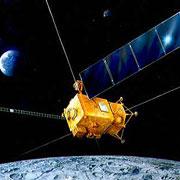 The main orbiter has 15 devices to monitor the Moon.NASA
The main orbiter has 15 devices to monitor the Moon.NASAJapan's much-anticipated lunar mission successfully launched from the Tanegashima Space Center at 10:31 a.m. (Japanese time) this morning.
The Japan Aerospace Exploration Agency (JAXA) is calling it the biggest lunar mission since NASA's Apollo programme. The JPY 32 billion (US$279 million) satellite, called the Selenological and Engineering Explorer (SELENE), will survey the Moon's mineralogy, topology and gravity gradients.
Over the next 20 days, SELENE will orbit Earth two-and-a-half times before heading to the Moon. On 9 October it will release a relay satellite into a large elliptical orbit around the Moon, to help transmit signals back to Earth. On 12 October it will release yet another satellite, also into a large elliptical orbit, to measure the Moon's gravity field with unprecedented precision.
“The great impact theory is probably right, but we need to have definitive proof.”
The main orbiter, which will enter a circular orbit 100 kilometres from the Moon's surface for a one-year mission, has 15 devices aboard. They include an X-ray spectrometer and a gamma-ray spectrometer for mapping the Moon's surface in unrivalled detail, and a terrain camera, laser altimeter and radar sounder that will provide surface and subsurface data for studying the Moon's tectonic history.
The Moon will never have been so closely characterized, say JAXA officials. The Apollo mission did only piecemeal mapping of the Moon's surface.
Lunar origin
Researchers hope that SELENE's data will resolve, once and for all, a basic question: where did the Moon come from? There have been several theories, with consensus now largely on the 'giant impact' theory. This states that another planetary body smacked into Earth some 4.5 billion years ago, and the lighter debris blown out by the collision collected to form the Moon.
Evidence for this argument lies in the similar isotope composition for Earth and the Moon, indicating that they are made of the same rock, and the lack of the heavy element iron in the Moon, which would not have been thrown outwards by the collision but stayed with the Earth. But a better understanding of the mineral composition of the Moon, and it's structure, would help to pin all this down. For example, mapping the thickness of the Moon's crust, which is generally thinner on the side nearest Earth, should help to firm up theories of how the satellite evolved after it was formed.
ADVERTISEMENT
"The great impact theory is probably right, but we need to have definitive proof," says Takahiro Iwata, a radio astronomer at JAXA
This morning's launch was the seventh successful one for Japan's once accident-prone rocket programme. "As a scientist who has put more than ten years into this project, it was a great relief," says Iwata. Japan has been increasingly ambitious about its space programme, and has loose plans to send astronauts to the Moon and construct a base there.
SELENE is referred to in Japan as 'Kaguya', after a mythical princess that returned to the Moon after scorning various suitors on Earth.
India, China and the United States all have lunar missions planned within the next year. NASA's Lunar Reconnaissance Orbiter, due to launch in 2008, also aims to survey the Moon's surface with a high level of precision. Private company flights may join the list of Moon missions too, spurred by a US$30 million prize, announced yesterday by the X-Prize foundation, for landing a privately funded robotic rover on the Moon.
Visit our moonsatellite_launch.html">newsblog to read and post comments about this story.
